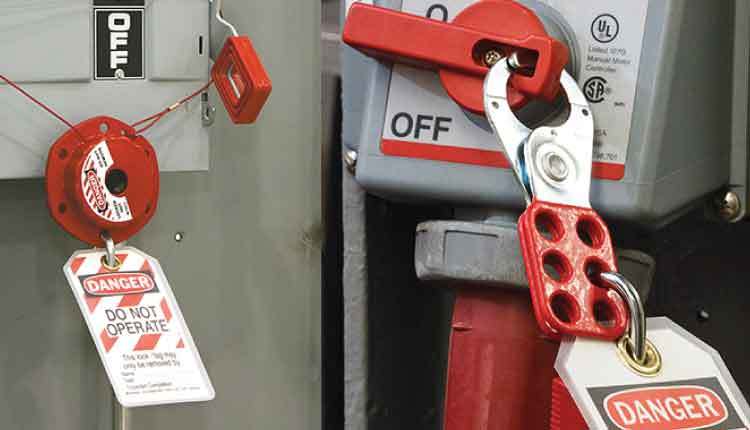The Occupational Safety and Health Administration (OSHA) regulations and standards regarding lockout/tagout are aimed at protecting the workplace, staff and machinery from accidents that may occur during maintenance or repairs. Despite elaborate recommendations and audits, fatalities still continue and their severities range from mild shocks and missing fingers to lost lives.
While using suitable lockout/tagout devices from specialist dealers such as lockoutsafety.com is a must to ensure adequate safety, it is equally important for the staff and technicians to strictly follow charted lockout processes to prevent any accidental damages.
A comprehensive range of lockout devices at lockoutsafety.com can help put together a custom kit for specific lockout programs.
Here are a few common lockout tagout mistakes that may prove fatal.
FAILURE TO DE-ENERGIZE
It is a common precaution to shut down the machine and disconnect it from the power source before putting it to work. However, some employees accidentally or deliberately skip this step.
There are a few other cases where units are energized using multiple sources, which makes it mandatory to identify all sources of energy and shut down all of them. A switch is just one intermediate powering device. Flipping it off is not equivalent to disconnecting the main power.
FAILURE TO DRAIN RESIDUES
Shutting down a piece of equipment or cutting off the power supply does not necessarily mean the unit is safe to handle. Energy stored in batteries, excess pressure built up within a system, machines still hot from their previous run, pipes still containing hot or toxic liquids and gases all need to be drained of residual substances – exposure to which can prove quite fatal.
FAILURE TO DOUBLE-CHECK THE SETTINGS
Making sure that the power sources are disconnected, movable machine parts firmly locked in place, residues emptied and equipment locked out is a must before commencing repairs.
Missing out of any of the above checks usually prove fatal.
Similarly, it is also important to check if tools and floors are cleared and all connections restored before unlocking and re-starting the machines to open up the place for regular use.
LACK OF TRAINING
Each employee entrusted with maintenance or repair jobs must be trained on safety and lockout procedures for systems and equipment under their control. Lack of training not only puts the technician’s life at risk but also compromises on the safety of others on the shop floor.
LACK OF EQUIPMENT-SPECIFIC LOCKOUT PROCEDURES
Specialized equipment or integrated systems that require elaborate lockout procedures should be handled with additional care. Specific lockout devices for each part and identification tags for each employee on the job are a must, without which the maintenance process could prove a challenge.
USE OF DUPLICATES/MASTER KEYS/SHARED LOCKS
It is usually normal for each technician to hold his or her own set of tagged lockout devices with a single key (to facilitate the task) for accountability, responsibility and traceability purposes. Duplicate or master keys may be used by others without fully verifying if the equipment or area has been cleared for operations. Sharing locks are a potential problem with equally dangerous consequences.
In most cases, it is also overconfidence, experience and familiarity with the facilities or procedures that influences people to overlook these lockout basics.
LOCKOUT TAGOUT AND ACCIDENT PREVENTION
Preventing accidents at the workplace is a joint responsibility of the employer and employees.
Getting a lockout/tagout program tailor-made for a specific work facility that has help specialists in the domain often proves helpful to address the complexities effectively.
While strict procedures are mandatory to ensure the lockouts go as planned, training staff and instilling a sense of responsibility is a must to avoid accidents.
Training should be imparted to not only personnel who actually man and maintain the equipment, but to all employees who have access to the workplace. They must be made aware of the lockout/tag out process, the relevance of tags and devices, and more importantly enlightened on why not to tamper with these tags or devices.
Periodical audits of the process are a must to verify if employees scale up to real-time challenges, identify shortfalls or areas of concern, and make appropriate changes to lockout procedures.
Laying out a clear set of policies for third-party service providers is a must to prevent accidents. The hired maintenance or repair firms must conform to visual indications and tags to ensure employees at the maintained facility recognize these warnings and avoid using equipment or areas that have been locked out.
Use of appropriate lockout devices and tags is necessary to get the right message across and get it noticed as well. A wide collection of lockout devices at www.lockoutsafety.com cater to diverse industrial requirements and can be further accessorized or customized to match the needs.
Opting for the right form of tags also makes a difference. Simple messages, engravings, bold colours or even photo ID tags can make the devices easily noticeable.
Visual indicators, posters or line diagrams right next to a specific system or machine can help people easily recognize power sources and movable parts, use the information either to lockout the equipment, or simply avoid accidentally starting up the system.
Limiting the use of master keys to unlock equipment can prevent untimely access to machines and equipment still being serviced, or areas that haven’t been cleared for use. The technician on the job is the best person to clear the area and machinery for use. During emergencies though, shackles can be broken to operate the equipment, but only after verifying the status of the task with the concerned employee.
Common, careless mistakes in handling heavy machinery and complex industrial systems do take a heavy toll. However, suitable lockout/tagout programs, policies, procedures, training and devices can make the process more effective and safe.
